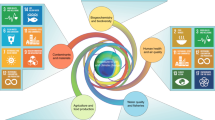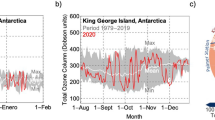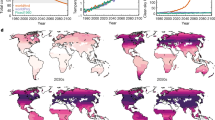Abstract
Stratospheric ozone shields the Earth from much of the solar UV – B radiation which is the most biologically injurious component of sunlight. It is possible that both human technologies and natural events, such as reversal of the Earth's magnetic polarity, might lead to significant ozone reductions. The methodology of evaluation of the impact of an agent such as solar UV on organisms or ecosystems has not been firmly established and there has been little research in this area in the past. A new approach is proposed here. If solar UV were an important injurious factor in nature, then living organisms would be required to expend energy to cope with the solar UV exposure they receive. If organisms must specifically mitigate solar UV injury, then it would be expected that only a minimal tolerance would be achieved. We have quantitatively estimated exposure and tolerance of a number of aquatic organisms and find them to be remarkably similar.
This is a preview of subscription content, access via your institution
Access options
Subscribe to this journal
Receive 51 print issues and online access
$199.00 per year
only $3.90 per issue
Buy this article
- Purchase on Springer Link
- Instant access to full article PDF
Prices may be subject to local taxes which are calculated during checkout
Similar content being viewed by others
References
Calkins, J., Buckles, J. D. & Moeller, J. R. Photochem. Photobiol. 24, 49–57 (1976).
Calkins, J. Proc. 3rd A. Conf. Climatic Impact Assessment Program, 505–517 (US Department of Transportation, DOT-TSC-OST-74-15, National Technical Information Service, Springfield, 1974); and in Climatic Impact Assessment Program Monogr. V, 33–71 (US Department of Transportation DOT-TST 75–55, National Technical Information Service, Springfield, 1975).
Robertson, D. F. in The Biologic Effects of Ultraviolet Radiation (ed. Urbach, F.) 433–436 (Pergamon, Oxford, 1969); thesis, Univ. Queensland (1972).
Berger, D., Robertson, D. F. & Davis, R. E. in Climatic Impact Assessment Program V, 233–264 (US Department of Transportation DOT-TST 75-55, National Technical Information Service, Springfield, 1975).
Morowitz, H. J. Science 111, 229–230 (1950).
Harm, W. Radiat. Res. 40, 63–69 (1969).
Barcelo, J. A. & Calkins, J. Photochem. Photobiol. 29, 75–83 (1979).
Calkins, J. Photochem. Photobiol. 8, 115–129 (1968).
Author information
Authors and Affiliations
Rights and permissions
About this article
Cite this article
Calkins, J., Thordardottir, T. The ecological significance of solar UV radiation on aquatic organisms. Nature 283, 563–566 (1980). https://doi.org/10.1038/283563a0
Received:
Accepted:
Issue Date:
DOI: https://doi.org/10.1038/283563a0
Comments
By submitting a comment you agree to abide by our Terms and Community Guidelines. If you find something abusive or that does not comply with our terms or guidelines please flag it as inappropriate.



